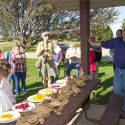From spinning atoms to blazing stars, Science Expeditions covers all bases
If there is any way to take in the full depth and breadth of the science being practiced and developed at the University of Wisconsin–Madison, the eighth annual Science Expeditions celebration is the way to do it.
On Saturday, April 10, UW–Madison will throw open lab doors all over campus and let the science out — inviting thinkers of all ages to revel in chemistry, physics, genetics, geology, meteorology, astronomy, food science, botany, anthropology and just about anything else subject to the theories, scopes and formulas of campus researchers.
Central to the day’s activities are a series of science spectaculars:
- The Wonders of Physics, at 11 a.m. and 2:15 p.m. in the Stock Pavilion, 1675 Linden Drive, draws assistant scientists from the audience to test the liquid nitrogen cannon and static electricity’s ability to levitate objects.
- The Combustion Show, at noon and 1:30 p.m. in the Stock Pavilion, features Students Participating in Chemical Education (SPICE) in search of the loudest boom.
- Chemistry in Action, at 12:45 p.m. and 3:15 p.m. in the Stock Pavilion, SPICE members demonstrate dramatic chemical transformations, spectacular catalysts and exciting energy exchanges.
- 100 Years of Genetics, at noon and 2 p.m. in the Genetics-Biotechnology Center, 425 Henry Mall, is a peek into how UW–Madison geneticists find the gene for a specific disease or create pesticide-resistant crops.
Hands-on activities will run from noon-4 p.m. in the Microbial Sciences Building (1550 Linden Drive), D.C. Smith Greenhouse (465 Babcock Drive), the Genetics/Biotechnology Center and the Biochemistry Addition (433 Babcock Drive).
The programs — all free and open to the public — are connected to exhibits and learning opportunities around campus by complimentary rides on a roving Red Trolley and the campus route 80 bus. Walking routes between Science Expeditions locations will be marked with scale model paths laying out the evolution of apes, composition of our solar system and 8 million years of geological upheaval on Earth.
A full schedule — including campus museums and dining opportunities — is available at the Science Expeditions Web site, http://science.wisc.edu/sciex2010.


